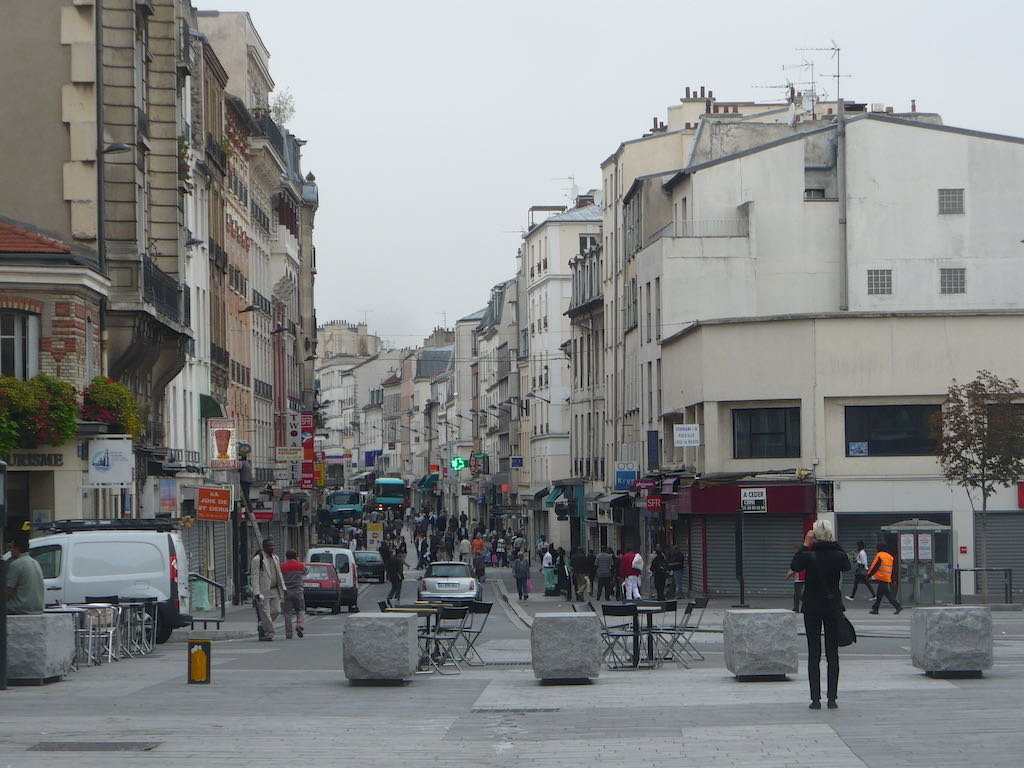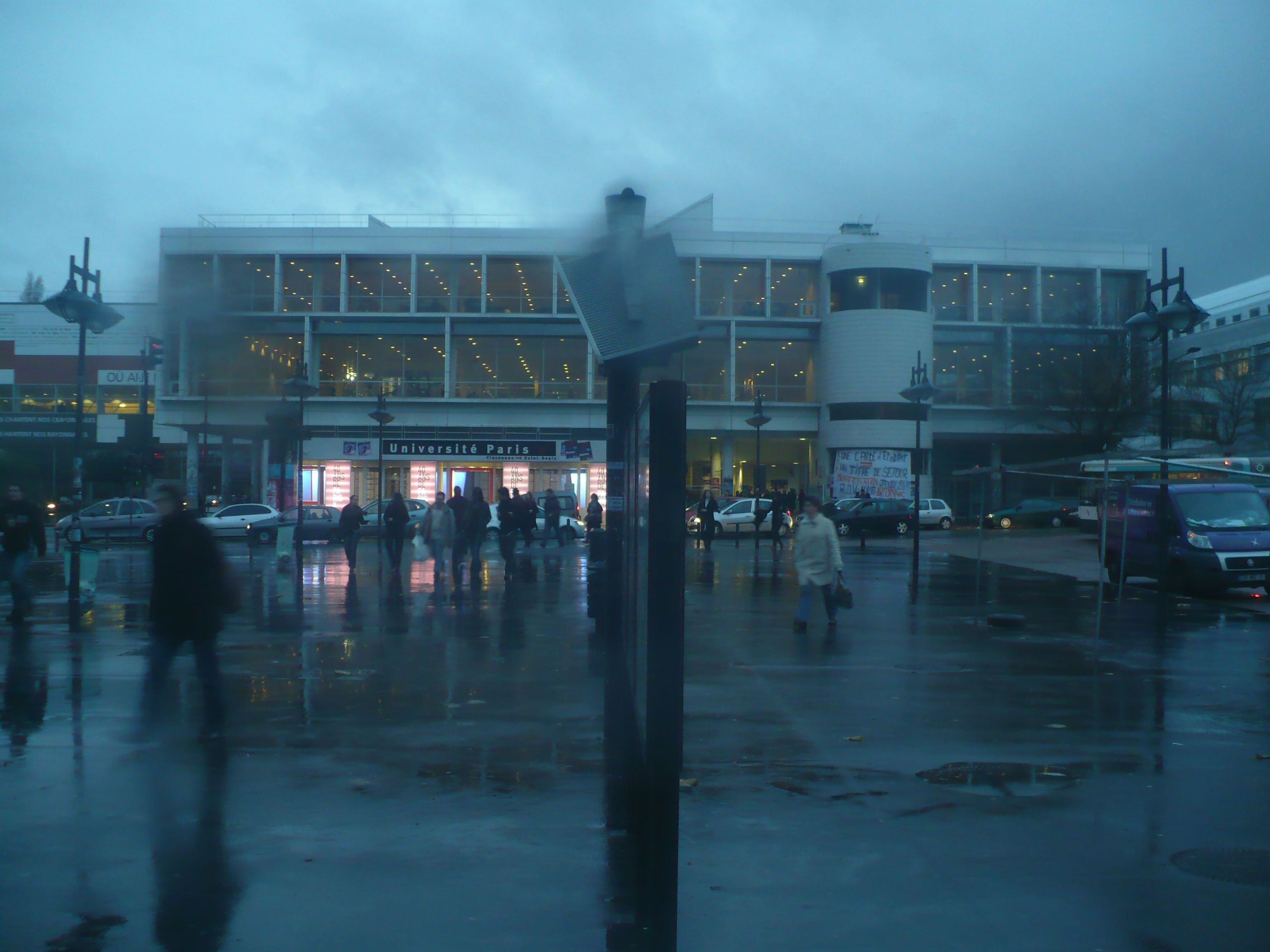Just north of Paris, near where the river Seine shifts from tourist attraction to concrete tunnel of industrial abandonment, sits the dense, polycultural city of Saint-Denis. It is a city gridded and hemmed by major highways, railway mainlines, disused canals, and further suburbs like Stains and Villetaneuse. If you were to follow Rue Gabriel Péri through the city’s historic downtown, you might pick up on the interspersed traces of the old white working class, the postwar “immigrant” populations with ties to North and West Africa, and the current waves of gentrifying bohemians. The city center is a study in social juxtapositions: coin laundromats and kebab shops, traditional brasseries and Arabic-language bookstores, hair salons and real estate brokers, Amstel bars and Taxiphone stores where you can call abroad for cheap. Near the river is the Place of the Victims of October 17, 1961, a plaza dedicated in 2007 to the memory of the Algerians who perished that day at the hands of the racist French police, their only crime that of protesting restrictions on their own civil liberties.[1] One day in the grocery store down the block from there, the shelves disheveled and half-empty, I watched a cashier crack up laughing as a band of loud youngsters, considered troublemakers, got shoved out the door. They banged angrily on the metal shutter brought down in their faces. At the central square, the City Hall—long run by the French Communist Party—mediates spatially and symbolically between a medieval abbey and a largely African market. Municipal billboards announce “the city of tomorrow,” though to me the city always felt entrenched in a hectic present. In the national imagination, Saint-Denis belongs to the bad side of the Parisian banlieue, the outskirts. It was situated in the notorious northern “Department 93,” which has become a target for reactionary anxieties about race, crime, Islam, and the working class.

If you kept going north past the City Hall, through a brutalist cement shopping plaza and across the tramway, you would come to the intersection of Rue de la Liberté and Avenue de Stalingrad. There, alongside a highway bridge under Avenue Lénine, you would find a famously left-wing university, the University of Paris 8 (Vincennes–Saint-Denis). If you discovered the one unlocked gate and weren’t hassled by the security guards, you might eventually find your way down a worn maze of corridors to the university’s storied Department of Philosophy. Looking out from the windows of the department’s main classroom, listening to the largely French, white, male professors, you would see a sky blocked by wire bars that kept out trespassers. It is a mystery why anyone would have wanted to break into this drab room, unpoetically named A028. For many years, on the wall across from the window, a disturbing piece of protest art depicted the Philosophy Department “getting smashed” in some sort of drug trip/explosion induced by the state apparatus. Outside in the hall, a bedraggled poster read “Apathy’s over, long live communism!”

Yes, the Department was a storied place: it was subtitled the “Department of Foucault, Deleuze and Lyotard” in marvelous Great-Man fashion. The university had been created in 1968 in the wake of the epic protest movement of that May-June, and decades later, it remained a crossroads of left intellectuals. The halls were dirty and the department was often in logistical disarray. But newer theory stars like Achille Mbembe, Judith Butler, and Giorgio Agamben were frequently invited to speak, and classes brimmed with esoteric knowledge about 19th century socialists, theories of “the symptom” or “the revolutionary hero,” philosophies of cinema or of labor. (Gender or race theory not so much, while I was there.) It was an academic department that was in many respects the negation of an academic department, a place where the border between “normal science” and utopian rupture was repeatedly erased and redrawn. And it encouraged reflexivity — up to a point. On one of the first days of my fieldwork, I approached a senior professor, Stéphane Douailler, and asked if I could do ethnographic research about the department. He examined me briefly through his spectacles, and then said wryly, “You can take us as your object.”
Douailler’s department was a hospitable place for me, as it had been for many other foreigners and political radicals. I admired its tolerance for intellectual exploration, utopian gestures, and overt political conflict. These are rare things in a university environment. Yet for all that, the department was never altogether comfortable either. Work was precarious, relationships could become strained, and much was left unsaid. I was left ambivalent, and my interlocutors were largely ambivalent too.
Perhaps it is disquieting for an ethnographer to be told, “You can take us as your object.” For even the utterance already reveals a certain force of subjectivity. Who in the end was the object, and who the subject? Sometimes I loved this site, finding a part of myself in it, but then, contradictions have long been my love language. The questions linger. If this institution was organized by structural forces of inequality, then how can a structurally unequal institution be the anchor point for something utopian? What does it mean to have a xenophilic philosophy department that welcomes the foreign Other, but has bars on its windows?
In the Introduction, I want to provide some conceptual grounds for thinking through these questions, an outline which the book will elaborate in more detail.
-
For English-language coverage, see “How to Forget a Massacre,” https://lareviewofbooks.org/article/how-to-forget-a-massacre-what-happened-in-paris-on-october-17-1961/. ↩